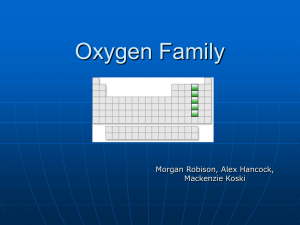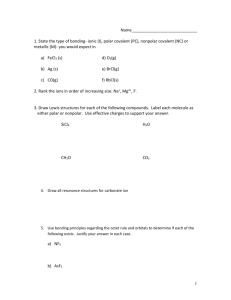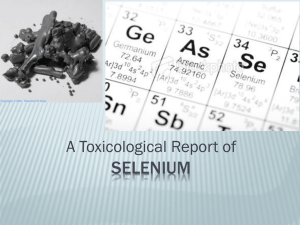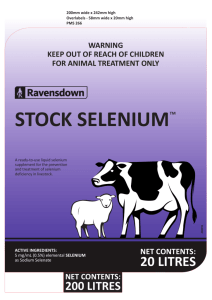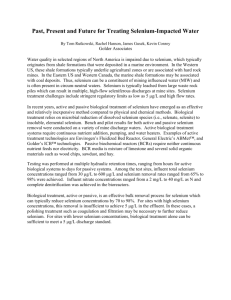Research Poster 36 x 48 - A
advertisement
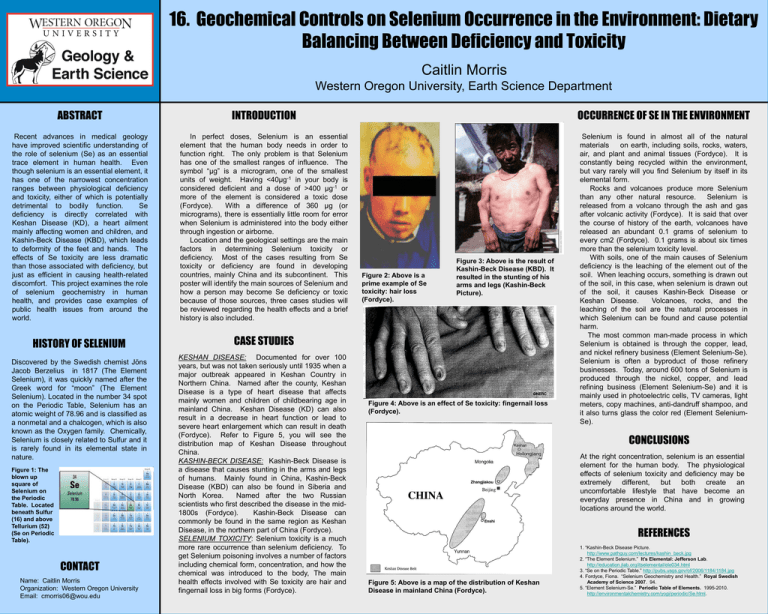
16. Geochemical Controls on Selenium Occurrence in the Environment: Dietary Balancing Between Deficiency and Toxicity Caitlin Morris Western Oregon University, Earth Science Department ABSTRACT INTRODUCTION OCCURRENCE OF SE IN THE ENVIRONMENT Recent advances in medical geology have improved scientific understanding of the role of selenium (Se) as an essential trace element in human health. Even though selenium is an essential element, it has one of the narrowest concentration ranges between physiological deficiency and toxicity, either of which is potentially detrimental to bodily function. Se deficiency is directly correlated with Keshan Disease (KD), a heart ailment mainly affecting women and children, and Kashin-Beck Disease (KBD), which leads to deformity of the feet and hands. The effects of Se toxicity are less dramatic than those associated with deficiency, but just as efficient in causing health-related discomfort. This project examines the role of selenium geochemistry in human health, and provides case examples of public health issues from around the world. In perfect doses, Selenium is an essential element that the human body needs in order to function right. The only problem is that Selenium has one of the smallest ranges of influence. The symbol “µg” is a microgram, one of the smallest units of weight. Having <40µg-1 in your body is considered deficient and a dose of >400 µg-1 or more of the element is considered a toxic dose (Fordyce). With a difference of 360 µg (or micrograms), there is essentially little room for error when Selenium is administered into the body either through ingestion or airborne. Location and the geological settings are the main factors in determining Selenium toxicity or deficiency. Most of the cases resulting from Se toxicity or deficiency are found in developing countries, mainly China and its subcontinent. This poster will identify the main sources of Selenium and how a person may become Se deficiency or toxic because of those sources, three cases studies will be reviewed regarding the health effects and a brief history is also included. HISTORY OF SELENIUM CASE STUDIES Selenium is found in almost all of the natural materials on earth, including soils, rocks, waters, air, and plant and animal tissues (Fordyce). It is constantly being recycled within the environment, but vary rarely will you find Selenium by itself in its elemental form. Rocks and volcanoes produce more Selenium than any other natural resource. Selenium is released from a volcano through the ash and gas after volcanic activity (Fordyce). It is said that over the course of history of the earth, volcanoes have released an abundant 0.1 grams of selenium to every cm2 (Fordyce). 0.1 grams is about six times more than the selenium toxicity level. With soils, one of the main causes of Selenium deficiency is the leaching of the element out of the soil. When leaching occurs, something is drawn out of the soil, in this case, when selenium is drawn out of the soil, it causes Kashin-Beck Disease or Keshan Disease. Volcanoes, rocks, and the leaching of the soil are the natural processes in which Selenium can be found and cause potential harm. The most common man-made process in which Selenium is obtained is through the copper, lead, and nickel refinery business (Element Selenium-Se). Selenium is often a byproduct of those refinery businesses. Today, around 600 tons of Selenium is produced through the nickel, copper, and lead refining business (Element Selenium-Se) and it is mainly used in photoelectric cells, TV cameras, light meters, copy machines, anti-dandruff shampoo, and it also turns glass the color red (Element SeleniumSe). Discovered by the Swedish chemist Jöns Jacob Berzelius in 1817 (The Element Selenium), it was quickly named after the Greek word for “moon” (The Element Selenium). Located in the number 34 spot on the Periodic Table, Selenium has an atomic weight of 78.96 and is classified as a nonmetal and a chalcogen, which is also known as the Oxygen family. Chemically, Selenium is closely related to Sulfur and it is rarely found in its elemental state in nature. Figure 1: The blown up square of Selenium on the Periodic Table. Located beneath Sulfur (16) and above Tellurium (52) (Se on Periodic Table). CONTACT Name: Caitlin Morris Organization: Western Oregon University Email: cmorris06@wou.edu KESHAN DISEASE: Documented for over 100 years, but was not taken seriously until 1935 when a major outbreak appeared in Keshan Country in Northern China. Named after the county, Keshan Disease is a type of heart disease that affects mainly women and children of childbearing age in mainland China. Keshan Disease (KD) can also result in a decrease in heart function or lead to severe heart enlargement which can result in death (Fordyce). Refer to Figure 5, you will see the distribution map of Keshan Disease throughout China. KASHIN-BECK DISEASE: Kashin-Beck Disease is a disease that causes stunting in the arms and legs of humans. Mainly found in China, Kashin-Beck Disease (KBD) can also be found in Siberia and North Korea. Named after the two Russian scientists who first described the disease in the mid1800s (Fordyce). Kashin-Beck Disease can commonly be found in the same region as Keshan Disease, in the northern part of China (Fordyce). SELENIUM TOXICITY: Selenium toxicity is a much more rare occurrence than selenium deficiency. To get Selenium poisoning involves a number of factors including chemical form, concentration, and how the chemical was introduced to the body, The main health effects involved with Se toxicity are hair and fingernail loss in big forms (Fordyce). Figure 2: Above is a prime example of Se toxicity: hair loss (Fordyce). Figure 3: Above is the result of Kashin-Beck Disease (KBD). It resulted in the stunting of his arms and legs (Kashin-Beck Picture). Figure 4: Above is an effect of Se toxicity: fingernail loss (Fordyce). CONCLUSIONS At the right concentration, selenium is an essential element for the human body. The physiological effects of selenium toxicity and deficiency may be extremely different, but both create an uncomfortable lifestyle that have become an everyday presence in China and in growing locations around the world. REFERENCES Figure 5: Above is a map of the distribution of Keshan Disease in mainland China (Fordyce). 1. “Kashin-Beck Disease Picture. http://www.pathguy.com/lectures/kashin_beck.jpg 2. “The Element Selenium.” It’s Elemental: Jefferson Lab. http://education.jlab.org/itselemental/ele034.html 3. “Se on the Periodic Table.” http://pubs.usgs.gov/of/2006/1184/1184.jpg 4. Fordyce, Fiona. “Selenium Geochemistry and Health.” Royal Swedish Academy of Science 2007. 94. 5. “Element Selenium-Se.” Periodic Table of Elements. 1995-2010. http://environmentalchemistry.com/yogi/periodic/Se.html.


